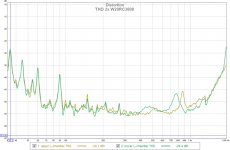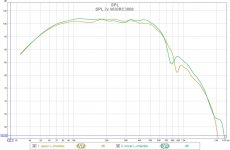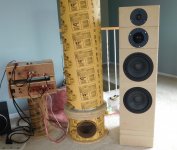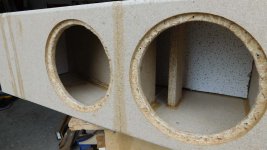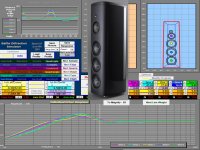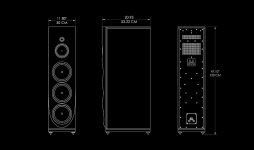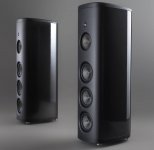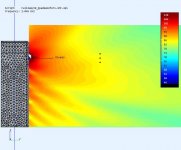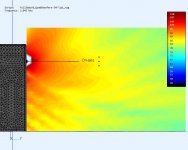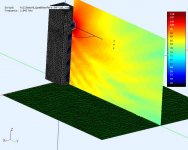two 8" woofers, two chambers
Two hours and $20 later I have a new woofer enclosure. This one was built for 2 SilverFlute W20RC3808 8" woofers to see if I can improve the bass/midbass response.
A quick run of HornResp provides Qtc=0.8 with about 20L/chamber (pic#1). So mine are actually 22L to account for the magnet and other material (acoustic tile + fiberglass) in the chamber (pic#2).
The measured individual woofer response is very close (pic#4) to HornResp. The THD (pic#5) is low and looks fine.
The system measured system response after level adjustment is show in pic#6, and #7. I've only had 1 hours to listen (@90dBc@1m) and it sounds good so far. I would prefer the woofers closer together and higher up near the midrange but I also don't want it any wider or deeper. Still thinking about how to do that.
Two hours and $20 later I have a new woofer enclosure. This one was built for 2 SilverFlute W20RC3808 8" woofers to see if I can improve the bass/midbass response.
A quick run of HornResp provides Qtc=0.8 with about 20L/chamber (pic#1). So mine are actually 22L to account for the magnet and other material (acoustic tile + fiberglass) in the chamber (pic#2).
The measured individual woofer response is very close (pic#4) to HornResp. The THD (pic#5) is low and looks fine.
The system measured system response after level adjustment is show in pic#6, and #7. I've only had 1 hours to listen (@90dBc@1m) and it sounds good so far. I would prefer the woofers closer together and higher up near the midrange but I also don't want it any wider or deeper. Still thinking about how to do that.
Attachments
-
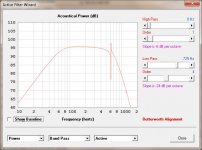 HornResp2x8in.jpg70.7 KB · Views: 770
HornResp2x8in.jpg70.7 KB · Views: 770 -
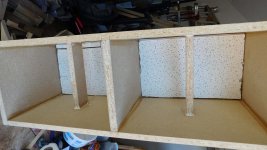 DSCN7743r.jpg147.2 KB · Views: 764
DSCN7743r.jpg147.2 KB · Views: 764 -
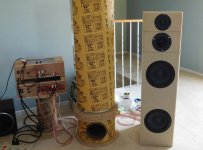 DSCN7746r.jpg411.8 KB · Views: 772
DSCN7746r.jpg411.8 KB · Views: 772 -
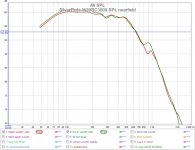 SPL SilverFlute W20RC3808 nearfield.jpg96 KB · Views: 773
SPL SilverFlute W20RC3808 nearfield.jpg96 KB · Views: 773 -
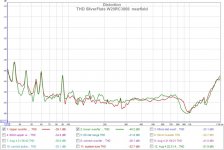 THD SilverFlute W20RC3808 nearfield.jpg105.2 KB · Views: 729
THD SilverFlute W20RC3808 nearfield.jpg105.2 KB · Views: 729 -
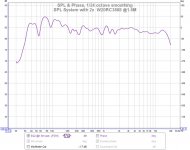 SPL System with 2x W20RC3808 @1.6M.jpg99 KB · Views: 183
SPL System with 2x W20RC3808 @1.6M.jpg99 KB · Views: 183 -
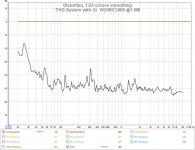 THD System with 2x W20RC3808 @1.6M.jpg98.1 KB · Views: 182
THD System with 2x W20RC3808 @1.6M.jpg98.1 KB · Views: 182
I thought about it some more and and moved the woofers closer to the midrange. There are now two irregular chambers of equal volume (22L) that allow closer woofer spacing. Despite the different chamber shapes both woofers measure very close in the nearfield. Damping material is acoustic tile and fiberglass.
Attachments
Are you planning a 3 or 3.5 way? With a midrange xo point @ 725Hz - I wonder for a 3 way what lobing / issues might result with the lower woofer that far away from the midrange? Of course the impact will lessen (?) the further away the listening distance.
Hi Dave,
The speaker is a 3 way with a BP6 sub beside it. The 8" woofers are in parallel and the wood space between top woofer and midrange perimeter is 3cm. So that leaves 20cm C-C between the mid and top woofer. The two woofers need to be considered together not independently (see below).
I listen at approx 2m from the speaker and have not noticed a problem yet, but it's still early 😉 I did have issues with the initial version so I changed it to push both woofers up.
Yes you can get some nearfield lobing, compare the BEM sim of a single 6.5" in Modular active 3 way - work in progress to the dual 6.5" in Modular active 3 way - work in progress .
The speaker is a 3 way with a BP6 sub beside it. The 8" woofers are in parallel and the wood space between top woofer and midrange perimeter is 3cm. So that leaves 20cm C-C between the mid and top woofer. The two woofers need to be considered together not independently (see below).
I listen at approx 2m from the speaker and have not noticed a problem yet, but it's still early 😉 I did have issues with the initial version so I changed it to push both woofers up.
Yes you can get some nearfield lobing, compare the BEM sim of a single 6.5" in Modular active 3 way - work in progress to the dual 6.5" in Modular active 3 way - work in progress .
looks good Don, Did you use a sloping baffle between the two volumes? I was trying to think of a way you could achieve what you wanted, and you obviously worked it out! 🙂
Tony.
Tony.
Hi Tony,
Yes, the box is split diagonally using a sloping internal partition. I was pleasantly surprised that the near field's measured so close given the different chamber shapes.
Yes, the box is split diagonally using a sloping internal partition. I was pleasantly surprised that the near field's measured so close given the different chamber shapes.
I got as far as the sloping baffle and then started worrying about the asymmetry, it appears that it wasn't a problem! That's the great thing about doing actual experiments! Keep up the great work 🙂
Tony.
Tony.
floor bounce
I was reading a thread on floor bounce and posted some simulation results at Why is floor bounce considered only a bass issue? and pondering whether it's an issue for me on this latest speaker. It's the first reflection and it's from the floor and it happens to all the speakers I own.
I'm also interested in knowing why I prefer the 2x8" woofers over the previous 2x6" woofers and was wondering if the floor bounce was partly responsible. Maybe the 2x8" have more area and are closer to the floor? Or maybe the larger 8" are becoming more directional with freq and less energy is hitting the floor?
Starting with a model comparison. This model is for my current setup and is comparing a 2Pi BEM sim to the actual measured result. My speaker sits on a rug so its not a perfect reflector like the model. The 3 dots in the BEM fields are at 1m distance and vertical centered on the midrange.
I was reading a thread on floor bounce and posted some simulation results at Why is floor bounce considered only a bass issue? and pondering whether it's an issue for me on this latest speaker. It's the first reflection and it's from the floor and it happens to all the speakers I own.
I'm also interested in knowing why I prefer the 2x8" woofers over the previous 2x6" woofers and was wondering if the floor bounce was partly responsible. Maybe the 2x8" have more area and are closer to the floor? Or maybe the larger 8" are becoming more directional with freq and less energy is hitting the floor?
Starting with a model comparison. This model is for my current setup and is comparing a 2Pi BEM sim to the actual measured result. My speaker sits on a rug so its not a perfect reflector like the model. The 3 dots in the BEM fields are at 1m distance and vertical centered on the midrange.
Attachments
-
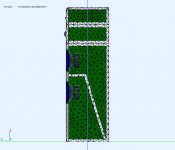 Dual8CrossSection.jpg61.9 KB · Views: 214
Dual8CrossSection.jpg61.9 KB · Views: 214 -
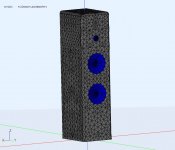 Dual8model.jpg62.2 KB · Views: 215
Dual8model.jpg62.2 KB · Views: 215 -
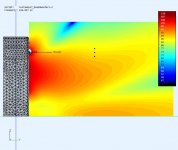 Field@616Hz.jpg52.3 KB · Views: 144
Field@616Hz.jpg52.3 KB · Views: 144 -
 Field@419Hz.jpg51.3 KB · Views: 142
Field@419Hz.jpg51.3 KB · Views: 142 -
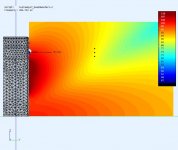 Field@284Hz.jpg51.4 KB · Views: 145
Field@284Hz.jpg51.4 KB · Views: 145 -
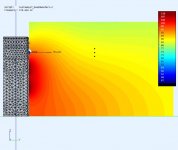 Field@176Hz.jpg48.9 KB · Views: 151
Field@176Hz.jpg48.9 KB · Views: 151 -
 Field@108Hz.jpg48.7 KB · Views: 184
Field@108Hz.jpg48.7 KB · Views: 184 -
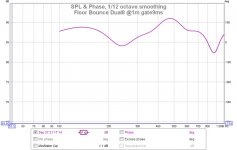 Floor Bounce Dual8 @1m gate9ms.jpg68.3 KB · Views: 174
Floor Bounce Dual8 @1m gate9ms.jpg68.3 KB · Views: 174 -
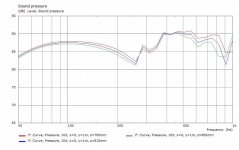 Floor Bounce Dual8 BEMsimjpg.jpg36 KB · Views: 221
Floor Bounce Dual8 BEMsimjpg.jpg36 KB · Views: 221
floor bounce
Another try to see if I can reduce the bounce. I've already tried a stacked woofer model, however this is more symmetric than the earlier one and has the entire cabinet. The surface area of the 2x8" woofers is about the same as 4x6.5" woofers.
Using the same Dynavox TC6028 woofers. The woofer rear chamber size is 9.8L which provides Qtc=0.9 according to a quick HornResp calc. A little higher than I'd like (0.7) but I also want to keep the cabinet size reasonable. A short stack of woofers is enough to provide a reasonable field up to my XO@725Hz. The midrange is turned off in this model.
I need more woofers 🙂
Another try to see if I can reduce the bounce. I've already tried a stacked woofer model, however this is more symmetric than the earlier one and has the entire cabinet. The surface area of the 2x8" woofers is about the same as 4x6.5" woofers.
Using the same Dynavox TC6028 woofers. The woofer rear chamber size is 9.8L which provides Qtc=0.9 according to a quick HornResp calc. A little higher than I'd like (0.7) but I also want to keep the cabinet size reasonable. A short stack of woofers is enough to provide a reasonable field up to my XO@725Hz. The midrange is turned off in this model.
I need more woofers 🙂
Attachments
-
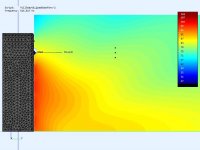 Field@616Hz.jpg48.3 KB · Views: 145
Field@616Hz.jpg48.3 KB · Views: 145 -
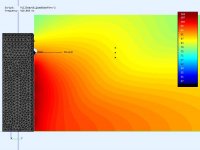 Field@419Hz.jpg49.6 KB · Views: 149
Field@419Hz.jpg49.6 KB · Views: 149 -
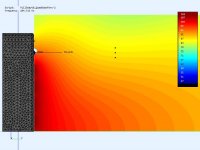 Field@284Hz.jpg49.4 KB · Views: 127
Field@284Hz.jpg49.4 KB · Views: 127 -
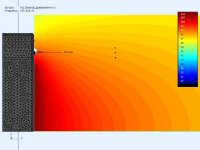 Field@176Hz.jpg48.8 KB · Views: 133
Field@176Hz.jpg48.8 KB · Views: 133 -
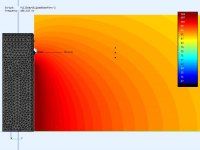 Field@108Hz.jpg48.5 KB · Views: 164
Field@108Hz.jpg48.5 KB · Views: 164 -
 Floor Bounce Quad6-5 BEMsim.jpg36.3 KB · Views: 168
Floor Bounce Quad6-5 BEMsim.jpg36.3 KB · Views: 168 -
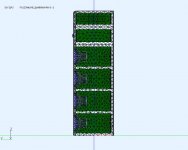 Quad6-5woofersCrossSection.jpg49.9 KB · Views: 163
Quad6-5woofersCrossSection.jpg49.9 KB · Views: 163 -
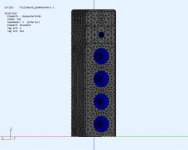 Quad6-5woofers.jpg52.1 KB · Views: 164
Quad6-5woofers.jpg52.1 KB · Views: 164
Last edited:
The literature on the $60K Magico Q5 with TMWWW topology should interest you. A simple baffle diffraction simulation illustrates the reduced distortion from the large radius edge rounds.
Type: Four-way, five-driver, sealed-enclosure, floorstanding loudspeaker
Driver complement: Two 9" woofers, one 9" mid/bass, one 6" midrange, one 1" tweeter
Sensitivity: 86dB 1w/1m
Impedance: 4 ohms, 2.75 ohms min.
Frequency response: 18Hz-50kHz +/-3dB
Minimum amplifier power: 50W
Dimensions: 11.8" x 47" x 12.5"
Weight (net): 420 lbs. each
Price: $60,000/pair
“As a work of industrial art, the Magico Q5 is beautiful...When you first listen to it, the Q5 may also sound uninvolving because it has little or no personality of its own. But in a loudspeaker, that's what you want. The longer I listened, the more I appreciated the Q5's ability to get out of the way and let the recording's own personality assert itself.”
— Michael Fremer, The Absolute Sound
Magico Q5 Loudspeaker (TAS 214) | The Absolute Sound
Type: Four-way, five-driver, sealed-enclosure, floorstanding loudspeaker
Driver complement: Two 9" woofers, one 9" mid/bass, one 6" midrange, one 1" tweeter
Sensitivity: 86dB 1w/1m
Impedance: 4 ohms, 2.75 ohms min.
Frequency response: 18Hz-50kHz +/-3dB
Minimum amplifier power: 50W
Dimensions: 11.8" x 47" x 12.5"
Weight (net): 420 lbs. each
Price: $60,000/pair
“As a work of industrial art, the Magico Q5 is beautiful...When you first listen to it, the Q5 may also sound uninvolving because it has little or no personality of its own. But in a loudspeaker, that's what you want. The longer I listened, the more I appreciated the Q5's ability to get out of the way and let the recording's own personality assert itself.”
— Michael Fremer, The Absolute Sound
Magico Q5 Loudspeaker (TAS 214) | The Absolute Sound
Attachments
...a thread on floor bounce...
There was a discussion of this in a thread on the Audio Science site.
Floyd Toole commented that the psychoacoutics on this wasn't settled.
We did evolve on some kind of surface, after all, even if dirt or rock rather than floor.
So our ears* are tuned to accept this.
I can find the link if you haven't already seen this.
Best wishes
David
Ears and auditory system, of course.
Last edited:
Thanks Dave, I have Floyd Toole's book and I remember reading that quote somewhere. I can't remember if it was in a interview or the book itself. The opinions are vary from control every reflection in the room to just ignore the room.
I was curious if I could reduce the floor reflection. It looks like I can for the woofers and now I'm working on what it would take for the midrange as well. I'll probably build it when I'm done just to see if I can tell the difference.
I was curious if I could reduce the floor reflection. It looks like I can for the woofers and now I'm working on what it would take for the midrange as well. I'll probably build it when I'm done just to see if I can tell the difference.
Toole's comment was focused against equalizing the first floor bounce per measured response (short gating) Typically this happens around 2-300Hz and is below Schroeder which means that we mainly hear reverberant sound.
I have played with eq and I must agree, floor bounce eq leads to bass-heavy sound. However I believe that it is wise to design the speaker so that there will be no or minimal floor bounce first null!
I have played with eq and I must agree, floor bounce eq leads to bass-heavy sound. However I believe that it is wise to design the speaker so that there will be no or minimal floor bounce first null!
Thanks Dave, I have Floyd Toole's book...
Me too, but only the 1st edition so I was interested to learn what his current ideas were.
I am not sure how much his ideas have altered since the first edition but apparently at least a little on some issues.
If you have the latest edition then you are probably up to date.
Very interested to see your own conclusions.
Best wishes
David
However I believe that it is wise...
I have attempted to maintain a somewhat narrower vertical directivity than horizontal in my own speakers.
This should reduce floor bounce but I haven't simulated it yet.
I hope this is in line with what you think is wise.
Best wishes
David
Toole's comment was focused against equalizing the first floor bounce per measured response (short gating) Typically this happens around 2-300Hz and is below Schroeder which means that we mainly hear reverberant sound.
I have played with eq and I must agree, floor bounce eq leads to bass-heavy sound. However I believe that it is wise to design the speaker so that there will be no or minimal floor bounce first null!
Agreed, there's no point trying to EQ a reflection null. I also thought Toole was commenting against alot of the digital room EQ in general. I should look it up again.
..more floor bounce
I thought I'd run some MF sims to understand this better. I use an RS52AN which has a 2" dome and it sprays sound very wide at 725Hz-4550Hz. Still, I like the sound of it.
Pic#1 - is 4Pi space (ie. anechoic chamber) and you can see diffraction from the cabinet and the 4 woofers.
Pic#2 - is 2Pi space bare (ie. concrete floor, no walls) and you can see the floor bounce as it swamps out the cabinet effects.
Pic#3,#4 - is 2Pi space with carpet in front (no walls) and you can see the performance starts looking like the 4Pi space again. Some (enough?) of the MF floor bounce is absorbed by the rug. My 2mx2m carpet model used R=0.5 starting at Ft=500Hz based on the info below.
Material reflection coefficients :
https://cds.cern.ch/record/1251519/files/978-3-540-48830-9_BookBackMatter.pdf
https://svetlanaroit.files.wordpress.com/2009/11/visual_values2.pdf
I thought I'd run some MF sims to understand this better. I use an RS52AN which has a 2" dome and it sprays sound very wide at 725Hz-4550Hz. Still, I like the sound of it.
Pic#1 - is 4Pi space (ie. anechoic chamber) and you can see diffraction from the cabinet and the 4 woofers.
Pic#2 - is 2Pi space bare (ie. concrete floor, no walls) and you can see the floor bounce as it swamps out the cabinet effects.
Pic#3,#4 - is 2Pi space with carpet in front (no walls) and you can see the performance starts looking like the 4Pi space again. Some (enough?) of the MF floor bounce is absorbed by the rug. My 2mx2m carpet model used R=0.5 starting at Ft=500Hz based on the info below.
Material reflection coefficients :
https://cds.cern.ch/record/1251519/files/978-3-540-48830-9_BookBackMatter.pdf
https://svetlanaroit.files.wordpress.com/2009/11/visual_values2.pdf
Attachments
Here is Floyd himself commenting and critisizing roomEQ -today!
An Enticing Marketing Story, Theory Without Measurement? | Page 29 | Audio Science Review (ASR) Forum
An Enticing Marketing Story, Theory Without Measurement? | Page 29 | Audio Science Review (ASR) Forum
Here is Floyd himself commenting and critisizing roomEQ -today!
An Enticing Marketing Story, Theory Without Measurement? | Page 29 | Audio Science Review (ASR) Forum
Thanks. LOL - "faith based audio" 🙂
- Home
- Loudspeakers
- Multi-Way
- Modular active 3 way - work in progress
